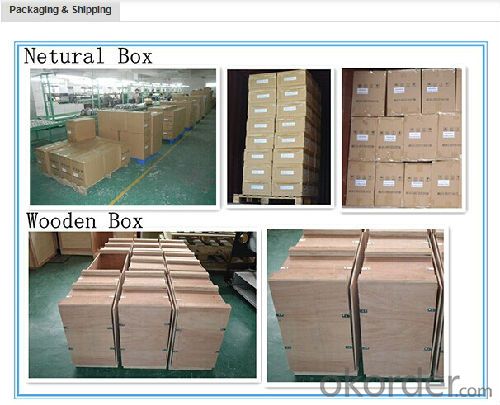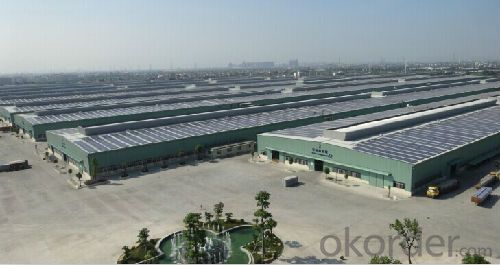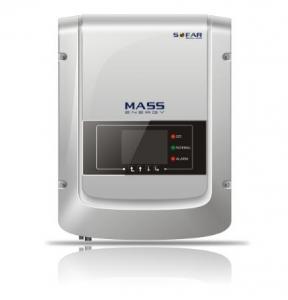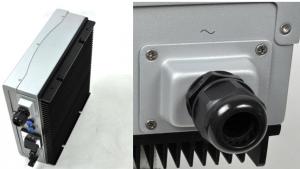Grid Connected Solar PV Inverter 2200TL 2200W
- Loading Port:
- Shekou
- Payment Terms:
- TT or LC
- Min Order Qty:
- 10 unit
- Supply Capability:
- 99999 unit/month
OKorder Service Pledge
OKorder Financial Service
You Might Also Like
Grid Connected Solar PV Inverter 2200TL 2200W
High-yield of Solar PV Inverter 2200TL
•Max 97.1%efficiency
•Real timeprecise MPPT algorithm for max harvest
•Wide inputvoltage operation range from 90V to 500V
All in one. Flexible and economicalsystem solution
•Free siteselection due to IP65
•Easy installationand maintenance due to “Plug & Play” connection
•Interfaceselection-Wi-Fi/ RS485 / Dry Relay for more flexible
•configurationandsystem monitoring
•4” LCDdisplay
•
Low maintenance cost of PV inverter
•Rust-freealuminumcovers
•Flexiblemonitoring solution
•Multifunctionrelay can be configured to show various inverter information
Intelligent grid management
•Reactivepowercapability
•Self powerreduce when over frequency
•Remoteactive/reactivepower limit control
PV inverter datasheet
Technical Data | 1100TL | 1600TL | 2200TL | 2700TL | 3000TL | |
Input (DC) | ||||||
Max. Input Power | 1100W | 1600W | 2200W | 2700W | 3000W | |
No. of MPPT / String per MPPT | 1/1 | |||||
Max. Input voltage | 450V | 450V | 500V | 500V | 500V | |
Max. Input Voltage | 80V | |||||
Rated input voltage | 360V | |||||
Operating input voltage range | 90V-400V | 100V-480V | ||||
MPPT voltage range | 110V-380V | 165V-380V | 170-450V | 210-450V | 230V-450V | |
Max. Input current per MPPT | 10A | 13A | ||||
Input short circuit current per MPPT | 12A | 15A | ||||
Output(AC) | ||||||
Rated power(@230V,50Hz) | 1000VA | 1500VA | 2000VA | 2500VA | 2800VA | |
Max. AC power | 1000VA | 1500VA | 2000VA | 2500VA | 2800VA | |
Max. AC Output Current | 4.5A | 7A | 9.5A | 11.5A | 13A | |
Rated Grid Voltage | 230V | |||||
Nominal Grid Voltage Range | 180V-270V(According to local standard) | |||||
Rated Frequency | 50Hz / 60Hz | |||||
Grid frequency Range | 44~55 / 54~66Hz(According to local standard) | |||||
THDi | <3% | |||||
Power factor Adjustable Range | 0.8 over excited … 0.8 under excited | |||||
Grid connection | Single phase | |||||
Efficiency | ||||||
Max. efficiency | 97% | 97.1% | ||||
Weighted eff.(EU/CEC) | 96% | 96.2% | 96.3% | |||
MPPT efficiency | >99.5% | |||||
Standard | ||||||
EMC | EN 61000-6-1, EN 61000-6-2, EN 61000-6-3, EN 61000-6-4 | |||||
RSSR | IEC 62109-1, IEC 62109-2 | |||||
Grid Standards | AS4777, VDE4105, C10-C11, G83/G59 (more available on request) | |||||
Protection | ||||||
Anti-Islanding Protection | Yes | |||||
DC reverse polarity protection | Yes | |||||
Over Temp Protection | Yes | |||||
Leakage Current Protection | Yes | |||||
Over Voltage Protection | Yes | |||||
Over Current Protection | Yes | |||||
Earth Fault Protection | Yes | |||||
Communication | ||||||
Standard Communication Mode | Wifi+RS485 | |||||
Operation Data Storage | 25 years | |||||
Relay | Yes | |||||
I/O | Yes | |||||
General data | ||||||
DC Switch | optional | |||||
Ambient temperature range | -25℃ ~ +60℃ | |||||
Topology | Transformerless | |||||
Cooling | Nature | |||||
Allowable relative humidity range | 0 ~ 95% no condensing | |||||
Max. Operating Altitude | 2000m | |||||
Noise | <35dB @1m | |||||
Degree of Protection (per IEC 60529) | IP65 | |||||
Dimension | 400*310*130mm | |||||
Weight | 11kg | 12kg | ||||
Self-consumption at night | 0 | |||||
Display | Graphic display | |||||
Warranty | 5 years | |||||


FAQ
1. Have any design tool and how to use it?
Shine Design is the system design software just for inverters, It can conduct installers to figure out panel numbers for a system, panel numbers for each string, and which inverter model is suitable for the system. Moreover, it can print a design report after input all necessary parameters, can calculate DC/AC wire wastage, annual generation, etc.
2. Does the inverter have monitoring solutions for residential system?
For small rating system, we have wired two monitoring solution (ShineNet via RS232 or RS485). (a) Local wireless monitoring solution (ShineVision via RF module communication) (b) Global wireless monitoring solution (WIFI module via WIFI network)
- Q:Can a solar inverter be used in a solar water pumping system?
- Yes, a solar inverter can be used in a solar water pumping system. The inverter is responsible for converting the direct current (DC) generated by the solar panels into alternating current (AC) required to power the water pump. This allows for efficient and reliable operation of the pumping system using solar energy.
- Q:Can a solar inverter be used with different types of communication protocols?
- Yes, a solar inverter can be used with different types of communication protocols. Many modern solar inverters are designed to be compatible with multiple communication protocols such as Wi-Fi, Ethernet, RS485, and Modbus. This allows for versatile integration with various monitoring systems, smart home technologies, and remote monitoring platforms, offering flexibility and convenience for users.
- Q:What is the role of a power management system in a solar inverter?
- The role of a power management system in a solar inverter is to efficiently manage the flow of electricity from the solar panels to the grid or the connected devices. It ensures that the power generated by the solar panels is optimized, regulated, and synchronized with the grid's requirements. The power management system helps in maintaining the stability and reliability of the solar inverter system by monitoring, controlling, and adjusting the power flow, voltage levels, and frequency to prevent overloading or underutilization of the solar energy.
- Q:What is the difference between a string inverter and a micro inverter?
- A string inverter is a type of solar inverter that is connected to a series of solar panels, converting the DC power produced by the panels into AC power for use in homes or businesses. A micro inverter, on the other hand, is installed on each individual solar panel, converting the DC power into AC power at the panel level. The main difference between the two is that a string inverter handles the entire string of panels, while a micro inverter operates on a per-panel basis. This means that micro inverters offer advantages such as increased energy production, better module-level monitoring, and improved system flexibility, but they can also be more expensive and complex to install compared to string inverters.
- Q:How does the voltage regulation affect the performance of a solar inverter?
- Voltage regulation is a crucial aspect of a solar inverter's performance. It ensures that the output voltage remains stable and within the required range, which directly impacts the efficiency and reliability of the solar inverter. Proper voltage regulation minimizes fluctuations in the output voltage, allowing the solar inverter to efficiently convert the DC power generated by the solar panels into AC power for use in electrical devices. Additionally, maintaining a stable voltage helps protect the connected electrical equipment by preventing overvoltage or undervoltage conditions that could potentially damage them.
- Q:Can a solar inverter be used in areas with high seismic activity?
- Yes, a solar inverter can be used in areas with high seismic activity. However, it is important to ensure that the solar inverter is designed to withstand and operate safely under such conditions. Solar inverters are typically built with robust and durable materials to be able to withstand various environmental factors, including seismic activity. They are often tested and certified to meet specific standards for seismic resistance. When installing a solar inverter in an area with high seismic activity, it is crucial to follow the manufacturer's guidelines and recommendations. This may involve using additional measures such as reinforced mounting structures, flexible connections, and proper grounding techniques to enhance the stability and resilience of the inverter system. Moreover, regular maintenance and inspections should be conducted to ensure that the solar inverter remains in good working condition even after seismic events. This includes checking for any signs of damage, loose connections, or other potential issues that may have been caused by seismic activity. By taking appropriate precautions and using seismic-resistant solar inverters, it is possible to safely and effectively harness solar energy even in areas prone to seismic activity.
- Q:Can a solar inverter be used in areas with unstable grid power?
- Yes, a solar inverter can be used in areas with unstable grid power. Solar inverters are designed to convert the DC power generated by solar panels into AC power that can be used by household appliances or fed back into the grid. In areas with unstable grid power, solar inverters can provide a reliable and consistent power supply by utilizing the energy stored in the solar panels or batteries. This ensures a continuous power supply, even during grid power fluctuations or outages.
- Q:Can a solar inverter be used with different types of grounding materials?
- Yes, a solar inverter can be used with different types of grounding materials. Solar inverters are designed to be compatible with various grounding systems, such as ground rods, ground plates, and grounding grids. The choice of grounding material may depend on local regulations, soil conditions, and the specific requirements of the solar installation. However, it is important to ensure that the chosen grounding material meets the safety standards and provides proper electrical grounding for the solar system.
- Q:What is the maximum power output of a residential solar inverter?
- The maximum power output of a residential solar inverter can vary depending on the specific model and capacity. However, on average, residential solar inverters typically have a maximum power output ranging from 3 kilowatts (kW) to 10 kW.
- Q:What are the key factors affecting the compatibility of a solar inverter with other system components?
- The key factors affecting the compatibility of a solar inverter with other system components include the power rating and voltage compatibility of the inverter with the solar panels, batteries, and electrical grid, as well as the communication protocols and interconnectivity requirements between the inverter and other system components. Additionally, the inverter's efficiency, protection features, and overall design should be considered to ensure seamless integration and optimal performance of the entire solar power system.
1. Manufacturer Overview |
|
|---|---|
| Location | |
| Year Established | |
| Annual Output Value | |
| Main Markets | |
| Company Certifications | |
2. Manufacturer Certificates |
|
|---|---|
| a) Certification Name | |
| Range | |
| Reference | |
| Validity Period | |
3. Manufacturer Capability |
|
|---|---|
| a)Trade Capacity | |
| Nearest Port | |
| Export Percentage | |
| No.of Employees in Trade Department | |
| Language Spoken: | |
| b)Factory Information | |
| Factory Size: | |
| No. of Production Lines | |
| Contract Manufacturing | |
| Product Price Range | |
Send your message to us
Grid Connected Solar PV Inverter 2200TL 2200W
- Loading Port:
- Shekou
- Payment Terms:
- TT or LC
- Min Order Qty:
- 10 unit
- Supply Capability:
- 99999 unit/month
OKorder Service Pledge
OKorder Financial Service
Similar products
New products
Hot products
Hot Searches
Related keywords
































